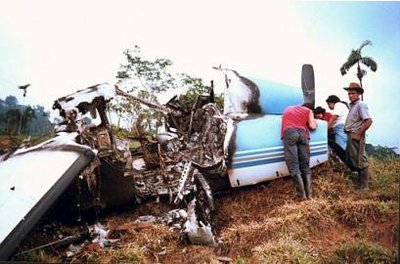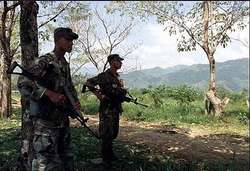Two Crashes, Five Deaths, Three Hostages
America's effort to interdict drug trafficking and oh-by-the-way
help Colombia fight its long-lived rebel insurgency has run into
major problems. Two airplane crashes, five deaths and three
hostages later, the New Orleans Times-Picayune reports the
surveillance program is all but dead in the water.

It started on February 13th. Four
American civilians, contractors for the military, along with a
Colombian intelligence officer, were flying a Cessna Caravan 208B
reconnaissance aircraft at about 5,000. They were using their
belly-slung surveillance pod to monitor activity in the jungle
below when it suddenly got awfully quiet.
Colombian Sgt. Alcides Cruz leaned forward and asked what was
going on. "Sir, that's an engine failure," pilot Tom Janis said.
They dove for a meadow and, miraculously, all five survived the
resulting ground impact.
But they were surrounded by Colombian insurgents, members of the
Revolutionary Armed Forces of Colombia, the FARC. Janis and Cruz
were executed on the spot. Marc Gonsalves, co-pilot Thomas Howes
and crew member Keith Stansill were taken hostage. They're now
bargaining chips in the decades-long war between Colombia and the
FARC.

That left one other aircraft available to employees of
California Microwave Systems, a subsidiary of Northrop Grumman,
which contracts the missions from the US military. On March 25th,
Ralph Ponticelli, James "Butch" Oliver and Thomas Schmidt took off
to find their missing comrades. They were flying low over the
jungle canopy when their wing apparently clipped a treetop. All
three were killed in the resulting crash.
In fact, there have been eight American aircraft down in
Colombia so far this year. Aside from the two surveillance crashes.
The State Department says four of those aircraft were shot down
while spraying herbicide on coca plants.
Pilots in the reconnaissance program wrote letter prior to
Janis's crash, voicing their grave concerns about flying a
single-engine aircraft on such long-range recon missions. They
noted there had already been one engine failure and they felt the
missions were becoming more and more risk-filled. One letter
written a year ago was apparently never addressed.
"The way the administration has managed civilian contractors in
Colombia is reminiscent of the space shuttle program," said Sen.
Patrick Leahy (D-VT). He's the top Democrat on the Senate Foreign
Operations Appropriations Subcommittee. That group holds the
checkbook for US foreign assistance programs. Aid to Colombia is
one of them. "It was a great program until the shuttle exploded;
then it turned out that NASA's managers were not aware of, or had
disregarded, the warnings of their own engineers. In Colombia, the
pilots' concerns were ignored and the families of those who died
are still in the dark about what happened. There has been lax
oversight and corners cut to stretch every dollar, and we have seen
the tragic consequences. Despite the problems, we have yet to hear
of any meaningful review of the program."

But the military, which runs the contractor program, wanted it
to be "cost-effective" and low-profile. Single-engine aircraft can
get in an out of more small, unimproved strips. They're cheaper to
operate. And the single-engine Caravan has an excellent safety
record.
"We put a lot of faith in that motor. It failed," said pilot
Thomas Howes, now a hostage. He was videotaped by a Colombian
reporter at a FARC camp in July. "Would we do it again? I don't
think any one of the three of us would put our faith in one motor
over the mountains of Colombia."
Stephen Lucas, who speaks for Southern Command (SOUTHCOM), which
coordinates the missions, writes, "As any aviator will tell you,
aviation is an inherently risky business, and an engine failure in
a single-engine aircraft is obviously potentially more catastrophic
than an engine failure on a dual- or multi-engine aircraft. To
professionals, this means greater emphasis on diligent execution of
appropriate maintenance, planning, and flight procedures and
operations, not the elimination of the aircraft from consideration
for a mission."
 The missions have become more
dangerous, ever since the American government loosened restrictions
on US efforts in Colombia. Until September 11th, 2001, the missions
could be nothing other than drug surveillance and interdiction.
Since the terror attacks, that restriction has been relaxed. There
are more night missions now.
The missions have become more
dangerous, ever since the American government loosened restrictions
on US efforts in Colombia. Until September 11th, 2001, the missions
could be nothing other than drug surveillance and interdiction.
Since the terror attacks, that restriction has been relaxed. There
are more night missions now.
"The safety cushion is greatly decreased under those
conditions," said one pilot in the program. "In bad weather, 300
miles away from search and rescue, in country controlled by
guerrillas, you are flying at night, in storms. You are cutting any
sort of safety redundancy out from under yourself.... The problem
was, we were making this look easy. We never had a problem, we made
it back and we made it look easy. It was mission creep. So it
became the norm to go out at night, in storms, with no
support."
But the pilots continued to fly. After all, they were civilians
making $150,000 or more a year. Apparently, not one of them ever
refused. So, to one pilot in the SOUTHCOM program, all the beefing
just doesn't make sense. "If the management gives me an airplane I
think is unsafe, I am not going to write a letter -- I am not going
to fly that airplane," he said. "It doesn't make any sense to me at
all."
 ANN's Daily Aero-Linx (04.17.24)
ANN's Daily Aero-Linx (04.17.24) ANN's Daily Aero-Term (04.17.24): Jamming
ANN's Daily Aero-Term (04.17.24): Jamming ANN's Daily Aero-Linx (04.18.24)
ANN's Daily Aero-Linx (04.18.24) Aero-News: Quote of the Day (04.18.24)
Aero-News: Quote of the Day (04.18.24) ANN's Daily Aero-Term (04.18.24): Hold-In-Lieu Of Procedure Turn
ANN's Daily Aero-Term (04.18.24): Hold-In-Lieu Of Procedure Turn






